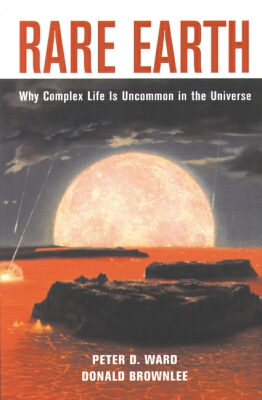

| RARE EARTH Why Complex Life Is Uncommon in the Universe Peter D. Ward Donald Brownlee New York: Copernicus, 2000 |
Rating: 4.0 High |
|||
| ISBN 0-387-98701-0 | 333p. | HC/GSI | $27.50 | |
They live in icebergs. They live in hot springs. They live in volcanic vents deep beneath the sea, and in fractured rock deep beneath Earth's surface. "They" are microbes — and we are discovering that they are tougher than we ever imagined, able to live in places where we thought life was impossible.
The best current evidence suggests that microbes arose on Earth soon after the planet's surface cooled and stabilized. They may have arisen several times, only to be blasted out of existence by asteroid impacts during the "heavy bombardment" period early in the solar system's history. There is a great deal we will never know about those distant eras. But the steady progress of science enables us to put some of the pieces together.
This book is an excellent review of how the pieces we have fit into the grand puzzle of the origin and development of life.1 Its authors are, respectively, professors of geology and astronomy at the University of Washington in Seattle. They were motivated to write this book by the torrent of discoveries, like the ones I mentioned regarding the hardihood of microbes, currently taking place in science. As they put it in their Introduction (page xiv):
The search in earnest for extraterrestrial life is only beginning, but we have already entered a remarkable period of discovery, a time of excitement and dawning knowledge perhaps not seen since Europeans reached the New World in their wooden sailing ships. We too are reaching new worlds and are acquiring data at an astonishing pace. Old ideas are crumbling. New views rise and fall with each satellite image or deep-space result. Each novel biological or paleontological discovery supports or undermines some of the myriad hypotheses concerning life in the Universe. It is an extraordinary time, and a whole new science is emerging: astrobiology. . . . We are witnesses to a scientific revolution, and as in any revolution there will be winners and losers—both among ideas and among partisans. |
As I've noted in other reviews, these many discoveries reinforce the long-held view that life, including intelligent life, must be common in the universe. It is the authors' contention, however, that while life in the form of microbes is common, complex life — meaning not just large animals and plants like the ones we find in such profusion on this planet, but any life made up of cells with nuclei and organelles2 — is very rare.
This is a rather brave stance to take. It flies in the face of a long-standing trend in science. That trend has led us to the Principle of Mediocrity, which says in essence that there is nothing special about Earth. If that is the case, then planets like Earth — and life like Earth life — ought to be common.
The authors take the opposite view, holding that Earth really is special. They base their arguments for this Rare Earth Hypothesis on emerging research findings from a number of disciplines. The arguments are complex, and impossible to summarize here. But the crux of the matter is easily stated. It is that a great many factors had to turn out just right to create the conditions that resulted in the life-forms we see around us today. (I've attempted to list those conditions in a table of requirements for complex-life habitats, but this in no way substitutes for the material in the book.) The authors have concluded, therefore, that while microbes are common in the universe, complex life is rare.
In my judgement, their arguments are persuasive but not conclusive. Primarily, this is because so many relevant questions are still unanswered — as the authors acknowledge throughout the book. But there are also flaws in their arguments. They tend to present findings as both definite and tentative, and sometimes contradict themselves or the words of sources they quote. This is probably due to clumsy writing rather than any defect in the authors' understanding; but it weakens their presentation considerably. Also, there is a larger than usual number of typos and grammatical errors. I list those in an errata page, linked below.
To sum up, it's clear that this is an important book. It stands in much the same relationship to astrobiology as Julian Brown's Minds, Machines, and the Multiverse does to the quantum computer. In other words, Rare Earth is one of the first books you should read if you're interested in the current state of research about life in the universe. Despite the defects I mentioned, it is in the main well and clearly written. It provides extensive reference lists, organized by chapter, and a detailed index. Recommended.

 To contact Chris Winter, send email to this address.
To contact Chris Winter, send email to this address.